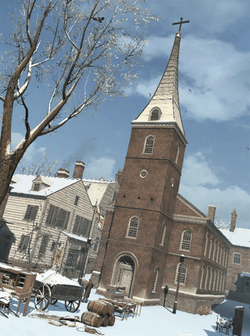Onesimus Mather in Freedom
In some respects that’s good because it means the man didn’t have to return to his former owner for support and thus get mentioned in his diary. (Because the minister would have been all over that.) Nor was Onesimus ever recorded entering the almshouse.
According to Mather, Onesimus had a wife and children while still enslaved. There’s no official record of this marriage, however. We don’t know the name of the wife or of any surviving children.
The vital records of Boston show two black men named Onesimus marrying and having children in Boston in the 1720s, the decade after Mather’s manumission. One of those men could have been the minister’s former servant marrying again—or perhaps neither were. Puritans knew the name of Onesimus from a slave mentioned in the New Testament, so they reused it.
The Rev. Joseph Sewall married one Onesimus to a black woman named Jane at the Old South Meeting-House on 3 June 1725. That couple baptized a son named William in that church on 23 Apr 1728. It’s not stated if they were enslaved or free.
The other Onesimus is more likely to have been the man who worked for Cotton Mather because he went to the Mathers’ meetinghouse in the North End to marry. This man was described as a free Negro when the Rev. Joshua Gee married him to a woman named Hagar on 15 Feb 1727. Gee was then Mather’s colleague at the church. Cotton Mather died a year later.
[Assuming, that is, that the marriage did indeed happen in what we now call 1727. The published Boston town records suggest that was a New Style date. But if the marriage actually took place on 15 Feb 1728, that was two days after the Rev. Dr. Mather died—too close to be a coincidence.]
The Old North Meeting’s records show Onesimus and Hagar having three children baptized:
- Onesimus on 22 Mar 1730.
- John on 10 Oct 1731.
- another Onesimus on 5 May 1734, and time Hagar is not on the record.
Twenty years later, in 1754, a “free negro” named Onesimus married a woman named Phillis, enslaved to Rachel Fessenden. Again, this could be the baby baptized in 1734 or it could be a completely unrelated man.
A more certain appearance of the Rev. Cotton Mather’s former servant appears in the Boston selectmen’s records of highway repairs. I’ll explore why that source exists in future postings. For this one, it’s necessary only to say that in some years the Boston selectmen made a list of all the free black men in town. As Eric Hanson Plass noted in his study of Boston’s early African-American community, this is as close as we have to a census of those men.
On 11 Nov 1725, the selectmen’s list included twenty-six Negro men, including one named “Onesimas." They were drafted for “Eight Days...in Clensing or Repairing the High wayes or other services for the Comon benefit.” Again, this could be either Onesimus who got married that decade.
Thirteen years later, on 13 Sept 1738, the selectmen drafted five men for one day’s work and sixteen men for two days. In the second group was “Onesimus Mather.”
This confirms that more than thirty years after being given to Cotton Mather, and more than twenty years after becoming free again, that man was still living freely in Boston. It’s also notable that he was using his old master’s surname, which of course carried great cachet in those parts. That’s why, even while I caution against assuming that ex-slaves adopted their former owners’ surnames, I feel comfortable referring to this free man as Onesimus Mather.

